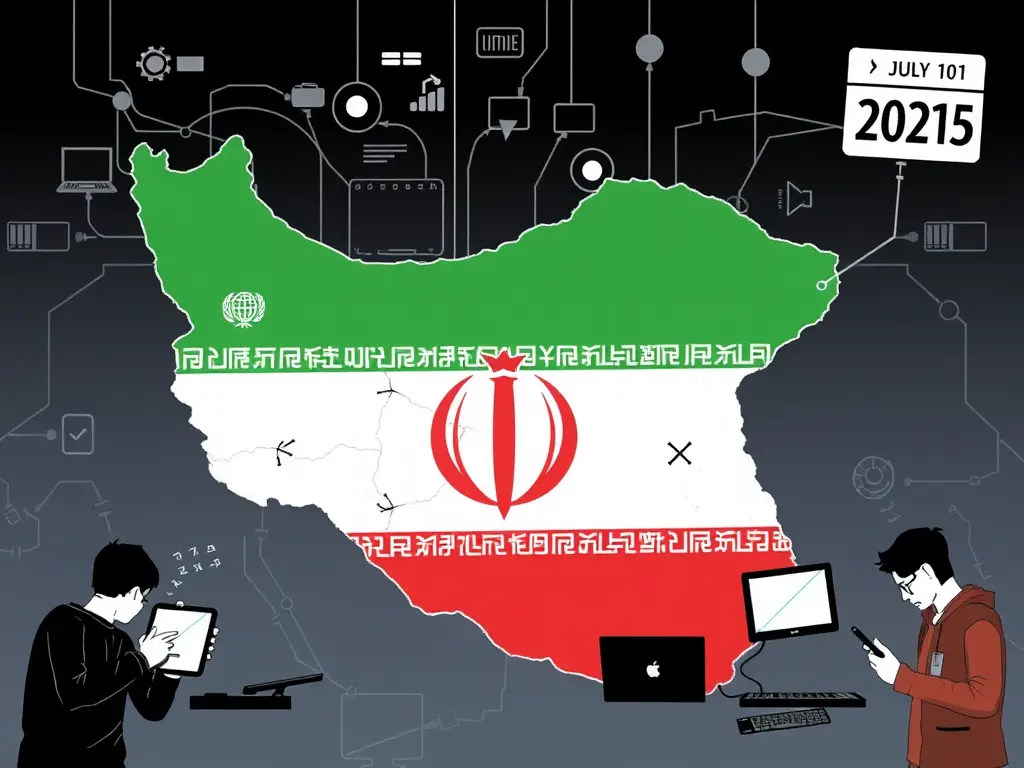Introduction: Iran’s Internet on July 10, 2025, a Crisis That Continued?
In today’s world, the internet is a vital artery of communication, business, and daily life. Its stability and speed directly impact all facets of society. In Iran, the state of the internet has consistently been a primary concern for users, economic actors, and even officials. Reports that emerged around July 10, 2025 (corresponding to ۲۰ تیر ۱۴۰۴) indicated “severe internet disruption” in the country. These reports, coming just two weeks after the announcement of a “ceasefire” in the communications sector, raised many questions regarding the promises of the Ministry of Communications and the future of the country’s internet infrastructure.
This article provides an in-depth examination of the report of severe internet disruption on July 10, 2025. We will explore the potential roots and causes of this disruption, its effects on people’s lives and businesses, and official reactions (if any). Our goal is to offer a comprehensive and impartial analysis of the internet situation during that period so that both ordinary users and IT experts can gain a better understanding of the challenges in this vital sector.
The Internet Situation Before July 10, 2025; What Happened After the “Ceasefire”?
To better understand what transpired on July 10, 2025, we must look at the state of the internet in the period preceding it. Users’ reference to “two weeks after the ceasefire” suggests a turning point or a prior agreement concerning the improvement or non-restriction of the internet. This “ceasefire” might refer to a temporary halt in implementing restrictions, promises to increase bandwidth, or an understanding between different governmental bodies regarding the management of cyberspace.
It was expected that following this “ceasefire,” we would witness a relative improvement in the quality and stability of the internet. However, the report of severe disruption on July 10, 2025, indicated that these expectations were not met, and the situation, instead of improving, had moved towards a “crisis.” This contradiction between promises and the reality on the ground created widespread dissatisfaction among users and businesses whose survival depends on the internet.
Analyzing the internet situation during this period requires examining public reports, technical data published by internet companies (if available), and official statements. This examination can reveal whether the disruptions were solely due to technical issues or if other factors, such as targeted restrictions, played a role.
Report of Severe Internet Disruption July 10, 2025; Nature and Extent
What types of disruptions were the reports published on July 10, 2025, referring to? Were these disruptions nationwide or limited to specific areas? Which services were most affected? The answers to these questions are key to understanding the nature of the internet crisis on that day.
Internet disruptions can take various forms: a drastic decrease in speed, complete loss of connection, difficulty accessing certain websites or specific services (like social media or foreign messaging apps), and increased latency (delay in response). Reports of “severe disruption” usually involve a combination of these issues or one of them at a large scale.
Examining public reports on social media and disruption reporting platforms can provide an initial picture of the geographical extent and type of disruption. Were users from all over the country complaining about slow or no internet? Was access only to international sites and services facing issues? These details can offer important clues about the main cause of the disruption. For instance, widespread and simultaneous disruption to foreign services could indicate problems at the international traffic exchange point or new filtering policies, while more localized disruptions might result from infrastructure issues at the provincial or regional level.
In addition to public reports, technical data received from network monitoring tools are also of high importance. Ping, traceroute, and download/upload speed graphs can objectively show the severity and type of disruption at different points in the network. Analyzing this data by technical experts can help in precisely identifying bottlenecks and problematic points in the country’s internet infrastructure.
Potential Causes of the July 10, 2025 Disruptions; Looking at the Roots
Identifying the main cause of the reported severe internet disruption on July 10, 2025, requires careful consideration of several potential factors. Technical issues, infrastructure problems, and policy decisions can all play a role in such disruptions.
One likely reason is technical problems in the network infrastructure. These could include equipment failures in data centers, cuts in fiber optic cables on main communication routes, or issues with core network routers and switches. High traffic load during peak hours can also lead to slowdowns and disruptions, especially if network capacity has not increased proportionally with demand growth.
Another factor could relate to updates or unintended changes in network configurations. Sometimes, implementing changes in network equipment configuration without proper coordination or testing can lead to widespread and unexpected disruptions. Cyberattacks such as DDoS (Distributed Denial of Service) attacks are also constantly a threat to network stability, although officials are typically cautious in providing transparent reports on this matter.
However, within the context of Iran’s internet, one of the most significant influencing factors is governmental decisions and policies. Targeted restrictions on access to certain foreign websites or services, increased filtering, or attempts to direct traffic towards the National Information Network can inherently cause disruption or slow down for users. The reference to a “ceasefire” and the lack of improvement afterward might indicate the influence of non-technical factors (political or managerial) in causing the July 10, 2025 disruptions.
Analyzing official reports (if available) and statements from officials regarding the cause of these disruptions is important, although sometimes these explanations are vague or insufficient, and the reality on the ground does not align with official reports.
Impact of the July 10, 2025 Disruption on People’s Lives and Businesses
The severe internet disruption on July 10, 2025, regardless of its cause, had significant negative impacts on people’s daily lives and the country’s economic activities. The increasing reliance of society on the internet means that any widespread disruption can have serious consequences.
For ordinary users, this disruption meant difficulty or impossibility of accessing information, using social media to communicate with friends and family, watching online content, or using online banking and government services. In a world where many daily tasks have moved online, internet disruption can cause wasted time, increased stress, and public dissatisfaction.
The impact of this disruption on businesses is far more serious. Online businesses, e-commerce stores, freelancers, knowledge-based companies, and even traditional businesses that use the internet for communication with customers or managing their operations, all suffered losses. The inability to process orders, communicate with customers, or access online work tools and platforms can lead to reduced revenue, loss of job opportunities, and weakening of the business environment.
Furthermore, vital sectors such as online education, remote work, and even some online medical services were also affected. Internet disruption can disrupt the education process for students, eliminate the possibility of remote work, and limit access to telemedicine services. These consequences show that internet disruption is not merely a technical problem but a social and economic issue with broad dimensions.
Official and Public Reactions; Silence or Transparency?
In the face of the reported severe internet disruption on July 10, 2025, what were the official and public reactions? Did officials provide transparent information about the cause and estimated duration of the disruption? What was the reaction of users and the community to this situation?
Experience shows that during widespread internet disruptions in Iran, official communication usually occurs with delay, and sometimes the explanations provided are not convincing for users. Was the situation similar on July 10, 2025? Did the Ministry of Communications or other responsible bodies issue a statement? Was the cause of the disruption (technical, infrastructural, or policy-related) clearly announced? The answers to these questions can impact the increase or decrease of public distrust regarding internet management in the country.
In contrast, public reaction is usually swift and widespread. Users share their experiences on social media, complain about the existing situation, and sometimes offer their own analyses regarding the cause of the disruption. Hashtags like #internet_disruption quickly trend, becoming a place for information exchange and expressing dissatisfaction. These public reactions, although sometimes accompanied by inaccurate information, indicate the importance of the internet for society and the public sensitivity to its stability.
Comparing official reports (if any) with users’ real-world experiences can reveal the gap between the official narrative and the actual reality. Transparency in reporting and accountability for the problems that arise are crucial steps towards rebuilding public trust and proper crisis management.
Lessons from the July 10, 2025 Disruption; Looking Ahead
The report of severe internet disruption on July 10, 2025, regardless of its precise causes, carries important lessons for stakeholders and users. This incident once again exposed the vulnerability of the country’s communication infrastructure and the serious consequences of internet instability.
For officials, this report is an alarm bell indicating that promises of improving the internet situation must be accompanied by practical and tangible actions. Sufficient investment in developing and updating technical infrastructure, increasing international bandwidth capacity, and transparency regarding restriction policies can help ensure greater network stability. Furthermore, developing and implementing crisis management plans for widespread disruption events is essential to ensure timely and accurate information dissemination and to take necessary measures to mitigate consequences.
For users and businesses, this disruption also highlights the necessity of being prepared to face such conditions. Having backup plans for accessing essential information and tools during internet outages, using offline services where possible, and geographically distributing activities to reduce risk can be beneficial. Additionally, increasing public awareness regarding users’ rights in the realm of the internet and pursuing demands through legal and civil channels is important.
The future of the internet in Iran largely depends on the approach of the government and responsible institutions towards this vital sector. Will the priority be the development of infrastructure and ensuring free and stable access for users, or will concerns about controlling and restricting cyberspace outweigh other considerations? The experience of July 10, 2025, showed that the current situation is far from expectations, and there is a long way to go to achieve a stable and reliable internet.
Conclusion
The report of severe internet disruption on July 10, 2025, serving as a bitter turning point, was a reminder of the fragility of internet infrastructure in Iran and its profound impacts on daily life and the country’s economy. This disruption, which occurred contrary to promises of improvement after a “ceasefire” period, raised serious questions regarding the effectiveness of policies and management in the communications sector.
To build a future where the internet is not a challenge but a powerful tool for growth and development, there is a need for sustained investment in infrastructure, increased transparency in decision-making and policymaking, and serious attention to the rights and needs of users and businesses. Overcoming internet crises requires a comprehensive approach that includes both technical dimensions and policy and social dimensions.
It is hoped that by learning from experiences like the July 10, 2025 disruption, more effective steps will be taken towards ensuring stable, fast, and free internet access for all Iranian citizens. Internet stability is the stability of life in the digital age.

